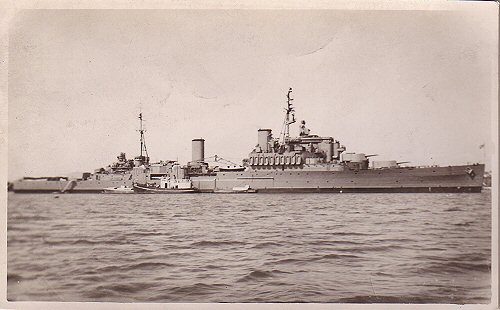
Sold 2 November 1959
HMS Newfoundland, a Colony Class Cruiser was launched in December 1941 by Mrs Ernest BEVIN, the wife of the then Minister of Labour, and completed in December 1942 when she joined the 10th Cruiser Squadron, Home Fleet, to work up with her new ships company.
Early in 1943 the ship became Flagship of the 15th Cruiser Squadron, Mediterranean and during the Sicily Campaign was torpedoed on the 23 July1943 by a German submarine U407, commanded byKptlt. Ernst-Ulrich Brüller, from 18 Dec, 1941 - 14 Jan, 1944.The submarine in question was in commission from18 Dec, 1941 - 19 Sep, 1944. She was dispatched on 19 Sept, 1944 in the Mediterranean south of Milos, in position 36.27N, 24.33E, by depth charges from the British destroyers HMS Troubridge and HMS Terpsichore and the Polish destroyer Garland. 5 dead and 48 survivors.
After limping to Malta, where temporary repairs were carried out, she crossed the Atlantic, steering by her propellers only as the steering gear had been damaged beyond use when torpedoed at Sicily, she eventually arrived at Boston Navy Yard where major repairs to her stern were undertaken. Following her return to Britain in 1944 the ship re-commissioned and sailed to the Far East. Whilst the ship was at Alexandria an explosion occurred in the port torpedo tubes, she suffered casualties and severe damage. The repairs delayed her arrival in the Far East to join the newly formed British Pacific Fleet.
The offensive against the Japanese occupied territories had been unleashed and as VE day was being celebrated in Europe HMS Newfoundland was supporting the landings by the 6th Australian Division at Wewak in New Guinea. Five days later the capture of the Wewak Peninsula and Airfield was effected. On the 14/15th June, as part of a Royal Naval Task Group, sea and air strikes were carried out on the Japanese Naval Base of Truk in the Caroline Islands .
On 6th July HMS Newfoundland left the forward base of Manus in the Admiralty Islands with other ships of the British Pacific Fleet to take part in the Anglo American attack on the mainland of Japan. These operations had been planned to pr-empt the invasion of the Japanese mainland on the 1st November 1945.
During this period, until the Japanese surrender, following the dropping of the Atomic Bombs, the ship was at sea continuously for 52 days, escorting the Aircraft Carriers, whose planes were attacking Japan on a daily basis, resisting air attacks, bombarding shore targets and finally putting a landing party of Royal Marines and Seaman ashore to take over the Naval Base at Yokosuka. The final chapter was being present in Tokyo Bay when the Instrument of Surrender was signed aboard the USS Missouri on the 2 September 1945.
The next major undertaking was to, participate in the urgent task of repatriating British and Commonwealth Prisoners of War. The ship eventually arrived back in the United Kingdom in December 1946.
Post War History
Following a post-war period in the Reserve Fleet and serving as a Stoker training ship at Torpoint, Cornwall, the ship was extensively modernised at Devonport and in November 1952 she re-commissioned for service on the Far East Station.
In April 1954, at the Cocos Islands, Newfoundland took over the escort of HM The Queen who was sailing on board the SS Gothic returning from a tour of Australia. The ship then accompanied Her Majesty to Aden.
By June 1954 the ship was back in the Far East bombarding the Malayan terrorists north of Penang.
After official visits to Bombay the ship eventually arrived back in Portsmouth in February 1955, having steamed some 65,000 miles since leaving her home port two years earlier.
After re-commissioning Newfoundland once again left for the Far East calling at Argostoli in Greece during April 1955 with relief stores after the earthquake there.
Following re-fitting at Singapore between May and August 1955 the ship paid visits to Korea and Japan. On the 4 June 1956 the ship was present at the celebrations of Foundation Day in Freemantle, Western Australia. In August 1956 the ship was again off the coast of Malaya bombarding the terrorists.
The ship was again scheduled to visit Australia for the Olympic Games, this had to be called off because of the Suez Canal crisis, the ship then made good passage to the Red Sea and Gulf of Suez and was stationed as the Senior Naval Officer's ship. During this brief period the Newfoundland engaged and sank the Egyptian frigate Domiat which had opened fire on her. Both ships sustained casualties. The ship eventually returned to Singapore and Hong Kong in January 1957.
Newfoundland commissioned for the last time with a new ships company at Singapore and during August saw service in the Persian Gulf after the coup d'etat in Iraq in which King Feisal was assassinated. The ship returned to Singapore in the September.
In April 1959 HMS Newfoundland finally left the Far East returning to the UK via the Seychelles, East and South Africa and Freetown, arriving in Portsmouth in June.
On 2 November 1959 HMS Newfoundland, after seventeen years of service was sold to Peru and re-named Almirante Grau. In 1973 she was re-named yet again as the Capitan Quinones, she was finally withdrawn from service in 1979.